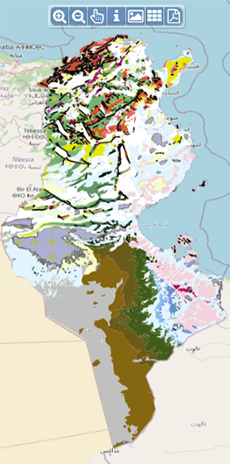| Annual program and technical progress report |
-

Activity Report 2024
-

Technical Program 2025
|
| Geocatalogue |

|
| Invitation to
tender |
-

Designation of a Lawyer or a Professional Law Firm to Represent the NOM
|
|
Invest in Tunisia |

|
|
|
|
|
::
Documentation and Editions
>>
Research library
|
| |
|
[
Search by author
]
[
Search keyword
]
[
Search by index
]
[
Search by category
]
|
title of the reference :
|
An independant test of planktonic foraminiferal turnovers acrossthe Cretaceous-Paleogene (K/P) boundary at El Kef, Tunisia :
|
|
Publication Date:
|
2000
|
|
Author :
|
Arenillas Ignacio, Arz José Antonio, Molina Eustoquio, Dupuis Christian
|
|
Catalogue type :
|
Livre
|
|
Catalogue reference :
|
Vol.46, N°1 Marine Micropaleontology Vol.46, N°1 An independant test of planktonic foraminiferal turnovers acrossthe Cretaceous-Paleogene (K/P) boundary at El Kef, Tunisia : catastrophic mass extinction and possible survivorship. "Planktic biostratigraphy and assemblage turnover across the Cretaceuos/Paleogene (K/P) boundary at El Kef revealed the largest and most abrupet extinction event in the history of planktic foraminifera. Cretaceous assemblages were very abundant and diverse and included 67 stable identified species within the terminal Maastrichtian. The mass extinction was characterized by the disappearance of (8,9%) species in the last 12 meters of the upper Maastrichtian and the axtinction of 46 (68,7% species at the K/P boundary as well as 15 (22,4%) possible survivors ranging into lowermost Danian. The range of planktic foraminifera only based on six samples (equivalent to the previous El Kef blind sample test) showed an even more catastrophic extinction pattern, with only 1 species disappearing before the K/P boundary. The K/P debate is the result of several problems which include the ""Signor-Lipps"" effect, the possibly of reworking and the existence of hiatuses. However, irrespective of the different interpretations we conclude that there were no signifiant nor quantitative changes before the K/P boundary and that most Cretaceous species suddenly became extinct at the K/P boundary Furthermore, possible Cretacious survivors had a smaller size and lower absolute abundance in the lower Danian than in the upper Maestrichtian and the planktic foraminiferal evolutionary radiation began above the K/P and not below.The same results have been found in other subtropical-temperate sections and may be sufficient proof for the existence of a catastrophic effects caused by the impact of a large extraterrestrial asteroid." bibliogr. Crétacé ; Paléocène ; Maestrichtien ; Danien ; Foraminifera ; biostratigraphie ; extinction masse ; astéroïde ; Tunisie ; Tunisie nord Occidentale ; El Kef Arz José Antonio Molina Eustoquio Dupuis Christian Arenillas Ignacio paleontologie
|
|
Indexation decimale :
|
paleontologie
|
|
Keywords :
|
Crétacé ; Paléocène ; Maestrichtien ; Danien ; Foraminifera ; biostratigraphie ; extinction masse ; astéroïde ; Tunisie ; Tunisie nord Occidentale ; El Kef
|
|
Summary :
|
"Planktic biostratigraphy and assemblage turnover across the Cretaceuos/Paleogene (K/P) boundary at El Kef revealed the largest and most abrupet extinction event in the history of planktic foraminifera. Cretaceous assemblages were very abundant and diverse and included 67 stable identified species within the terminal Maastrichtian. The mass extinction was characterized by the disappearance of (8,9%) species in the last 12 meters of the upper Maastrichtian and the axtinction of 46 (68,7% species at the K/P boundary as well as 15 (22,4%) possible survivors ranging into lowermost Danian. The range of planktic foraminifera only based on six samples (equivalent to the previous El Kef blind sample test) showed an even more catastrophic extinction pattern, with only 1 species disappearing before the K/P boundary. The K/P debate is the result of several problems which include the ""Signor-Lipps"" effect, the possibly of reworking and the existence of hiatuses. However, irrespective of the different interpretations we conclude that there were no signifiant nor quantitative changes before the K/P boundary and that most Cretaceous species suddenly became extinct at the K/P boundary Furthermore, possible Cretacious survivors had a smaller size and lower absolute abundance in the lower Danian than in the upper Maestrichtian and the planktic foraminiferal evolutionary radiation began above the K/P and not below.The same results have been found in other subtropical-temperate sections and may be sufficient proof for the existence of a catastrophic effects caused by the impact of a large extraterrestrial asteroid."
|
|
Exemplaries :
|
TU2005
|
|
|
|
|
|
|
|



